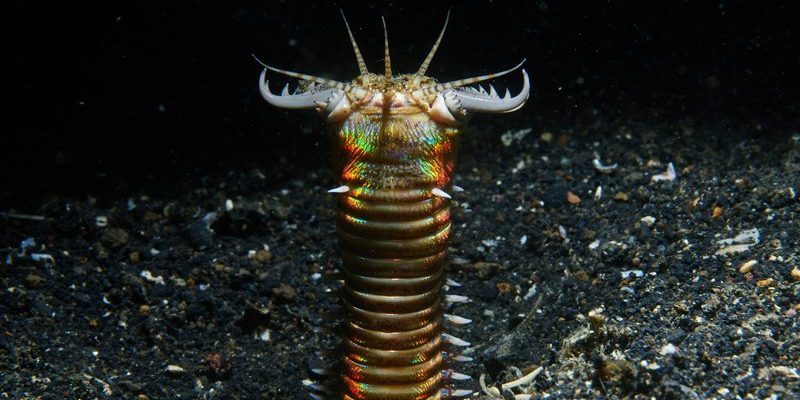
You might not be familiar with the Bobbit worm (Eunice aphroditois)—and that’s okay! It’s an impressive creature with a long, segmented body and a voracious appetite for small fish and invertebrates. Think of it like a surprise guest at a party who shows up uninvited and eats all your snacks. By understanding how to manage the risks of transferring Bobbit worms through live rock, you can keep your aquarium healthy and thriving.
What Are Bobbit Worms, and Why Should You Care?
Honestly, Bobbit worms sound like something out of a science fiction movie, don’t they? These creatures can grow up to ten feet long and are masters of camouflage, hiding in the sand or rock while waiting for unsuspecting prey. They’re known for their fierce hunting skills, using their sharp jaws to snatch up fish in the blink of an eye.
Now, you might be wondering, why should I care about these worms? If you’re a beginner setting up a saltwater tank, Bobbit worms can wreak havoc on your ecosystem. Once they establish themselves, they can be very difficult to remove without tearing down your entire setup. Protecting your investment means being proactive about what you introduce into your aquarium.
How Do Bobbit Worms Get into Your Aquarium?
Let’s delve into the primary way these worms can find their way into your tank: live rock. When you purchase live rock, it often comes with a whole host of hitchhikers, some harmless and others not so much. Unfortunately, **Bobbit worms** are often stowed away in these natural rock pieces, hiding among coralline algae and beneficial microbes.
Here’s the kicker: when you place unwashed or unquarantined live rock into your aquarium, you might unknowingly give Bobbit worms a free ride to their new home. This is a classic case of “out of sight, out of mind,” and it’s exactly why you need to be careful. Always check the source of your live rock and consider the potential risks before making a purchase.
Preventing Bobbit Worm Introduction Through Live Rock
Let me explain some practical steps you can take to keep those unwanted guests out of your aquarium. Prevention is always better than cure, right? Here are some key strategies:
- Quarantine Your Live Rock: Before introducing live rock to your tank, it’s a good idea to quarantine it in a separate tank for a few weeks. This gives you time to spot any unwanted hitchhikers, including Bobbit worms.
- Inspect Carefully: When you receive your live rock, take a good look at it. Examine it closely for any signs of worms or other pests. If you see something suspicious, don’t hesitate to ask the supplier about it.
- Use a Dip Treatment: Some aquarists recommend using a dip treatment like a saltwater bath with a small amount of hydrogen peroxide. This can help kill off parasites while still preserving beneficial bacteria.
These preventive measures can save you a lot of headaches down the road.
Identifying Bobbit Worms in Your Aquarium
If you’ve already introduced live rock into your tank and are worried about Bobbit worms, keep an eye out for signs of their presence. These can be tricky to spot, but look for the following indicators:
- Popping Out: You may see their segmented bodies poking out of the substrate or hiding between rocks, especially during feeding times.
- Missing Fish: If you notice fish disappearing without a trace, it might not be just a case of them finding a new hiding spot. Think about possible predators like Bobbit worms.
- Burrowing Behavior: If you notice unusual digging or burrowing in your substrate, it could be a sign that a Bobbit worm is at work.
Being observant can help you catch these sneaky creatures before they become a problem.
What to Do If You Find a Bobbit Worm
If you do find a Bobbit worm in your setup, don’t panic! Here are a few options for dealing with the situation:
- Manual Removal: If it’s safe and possible, you can try to remove the worm with a pair of tweezers. Be cautious: they can bite, so wear gloves.
- Trap It: Use a trap designed for marine pests. You can lure it with food and catch it that way.
- Consult an Expert: Sometimes, it’s best to reach out to a local aquarium professional. They can provide advice tailored to your specific situation.
Remember, the goal is not to let them wreak havoc on your aquatic community.
Creating a Healthy Environment Post-Bobbit Worm
If you’ve dealt with Bobbit worms and managed to remove them, it’s time to focus on creating a healthy environment for your tank. **Stable water conditions, good filtration, and a balanced ecosystem** are vital for keeping everything thriving. Regular testing of water parameters can help you spot any issues early on.
Additionally, consider introducing **clean-up crews** like snails or hermit crabs. These creatures can help maintain your tank’s health and prevent other pests from becoming an issue. They can often outcompete unwanted intruders for food, thus keeping your aquarium in balance.
Setting up a saltwater aquarium can be an exciting adventure, but it’s essential to be mindful of what you introduce into your tank. By taking precautions against accidental Bobbit worm transfer via live rock, you can ensure a thriving ecosystem for your fish and corals. Remember, prevention and awareness are your best friends in keeping your aquarium healthy and vibrant. Stay curious and enjoy the process—your aquatic world is waiting!

